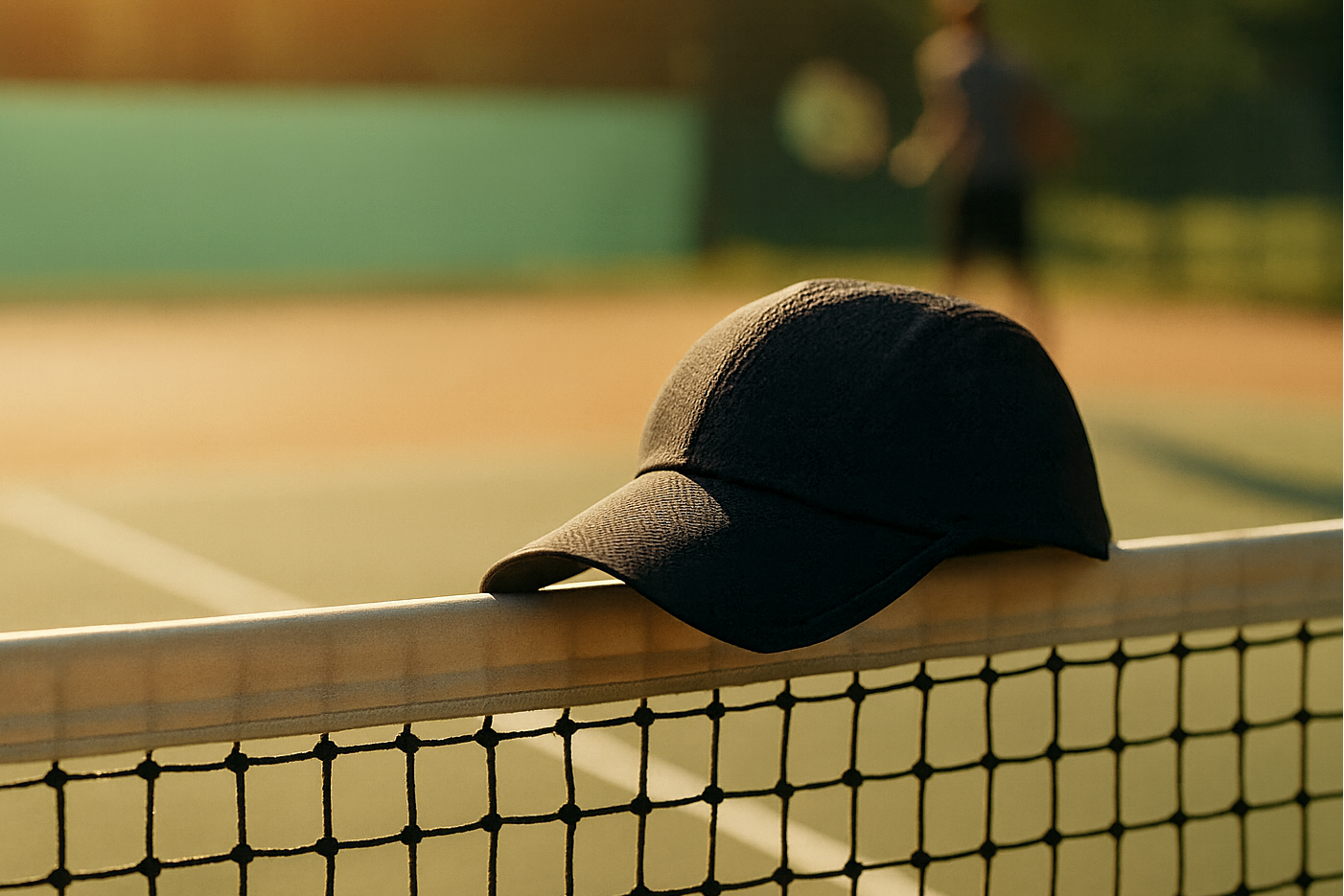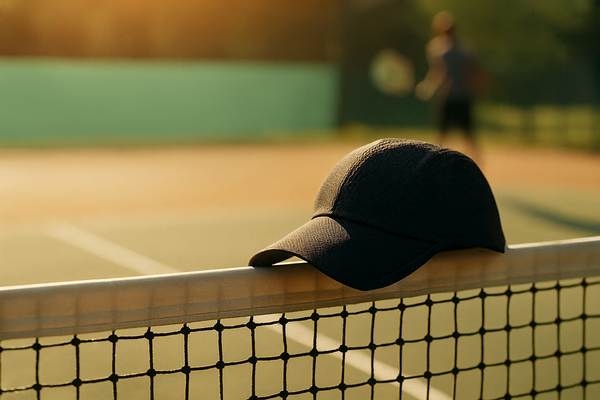Casquette ou pas ? Pourquoi certains pros du tennis portent une casquette (et d'autres non)
Introduction
Sur n'importe quel court extérieur, il est facile de comprendre pourquoi un joueur de tennis porte une casquette : protection contre l'éblouissement, protection contre la transpiration, vision plus nette pour le service. Et pourtant, juste de l'autre côté du filet, son adversaire pourrait se retrouver face à la même lumière : sans casquette, sans visière, sans ombre, mais concentré sur sa propre attention. Du bandeau classique de Federer à la casquette signature de Victoria Mboko, le choix de porter (ou non) une casquette est aussi personnel qu'une prise de balle ou un rituel entre les points. Est-ce une question de performance, de confort ou d'identité ? La réponse, comme le jeu lui-même, se trouve quelque part entre les deux.
La fonction avant tout : l'ombre et la transpiration
Pour de nombreux pros, l'idée est simple : une casquette offre de l'ombre. Le bord réduit l'éblouissement lors des lancers et des volées, surtout sur les courts très ensoleillés comme ceux de Melbourne ou de New York. Les matériaux sont ici essentiels : polyesters légers et empiècements en mesh permettent une bonne circulation de l'air tout en protégeant les yeux. Des bandeaux anti-transpiration intégrés au bord absorbent et évacuent l'humidité, évitant ainsi les irritations oculaires.
Mais l'ajustement est crucial. Une casquette qui bouge pendant un service, ou une casquette fabriquée dans des tissus qui absorbent simplement la transpiration au lieu de l'évacuer, peut s'avérer problématique : elle devient lourde, saturée et laisse la sueur atteindre les yeux. C'est pourquoi de nombreux joueurs optent pour des visières structurées et des tissus qui évacuent l'humidité et sèchent rapidement entre les matchs.
Note de spécification : tissus évacuant l'humidité
Contrairement au coton, qui absorbe et retient la transpiration, les mélanges techniques évacuent l'humidité de la peau et sèchent rapidement. Cela permet de garder les casquettes légères, d'éviter les déperditions et de réduire les distractions en milieu de match.
Confort, chaleur et habitude
Tous les joueurs ne trouvent pas les casquettes confortables. Les tissus denses peuvent emprisonner la chaleur, ce qui augmente la sensation de chaleur au niveau de la tête dans des conditions déjà difficiles. C'est là que les bandeaux, les bandanas, voire rien du tout, entrent en jeu : ils permettent une circulation d'air maximale et allègent la tête. Les bandanas signature de Nadal, par exemple, évacuent la transpiration sans couvrir la tête.
Et puis il y a les bracelets : une solution classique pour les joueurs qui ne portent pas de casquette. Un simple coup de poignet sur le front évacue la transpiration avant qu'elle ne distrait les yeux, ce qui permet de jouer de manière fluide sans ajout supplémentaire. Pour certains, c'est plus léger et plus naturel que de porter une casquette.
Le confort, le rituel et la familiarité peuvent l'emporter sur tout avantage technique, faisant du port de la casquette une question d'identité personnelle plutôt que de performance. D'autres considèrent la casquette comme un élément de leur identité sur le court ; les visières de Serena, par exemple, sont aussi reconnaissables que son service. Avec le temps, ces choix se transforment en rituels, et ces rituels peuvent être aussi importants que les raquettes.
Le jeu mental
Le tennis est autant psychologique que physique. Porter une casquette peut donner l'impression d'enfiler une armure : un signal que le match a commencé, un moyen de bloquer les distractions, voire un outil d'intimidation. Le bord rétrécit la vision et aiguise la concentration. À l'inverse, certains joueurs perçoivent le fait de ne pas en porter comme une forme de liberté – une façon de jouer sans barrières, de s'ouvrir à l'environnement, comme s'ils refusaient tout filtre entre eux et le jeu.
Ici encore, le choix des matières joue un rôle crucial : la sensation du tissu sur la peau, l'ajustement serré, la respirabilité du tissage. Les petits détails deviennent des repères mentaux : le confort renforce la confiance, et la confiance est souvent synonyme de victoire.
Les matériaux qui comptent sur le terrain
Tous les tissus ne se valent pas, surtout lorsqu'ils sont assortis à cinq ensembles. Voici ce qui fait la différence :
Polyester léger - durable, conserve sa forme et sèche rapidement, une norme pour les casquettes de performance.
Panneaux en maille - améliorent la ventilation et le flux d'air, gardant la tête plus fraîche en cas de mouvement constant.
Bandeaux anti-transpiration intégrés - absorbent l'humidité au niveau du bord, l'empêchant de couler dans les yeux au milieu du rallye.
Mélanges évacuant l'humidité - évacuent la transpiration de la peau et sèchent rapidement, évitant ainsi cette sensation de lourdeur et d'humidité.
Coton (moins courant) - confortable mais plus lent à sécher, plus susceptible de sembler lourd lors des longs matchs.
Les meilleures casquettes de tennis combinent respirabilité et contrôle de la transpiration, afin que les joueurs puissent se concentrer sur leur jeu, pas sur leur équipement.
Note de spécification : tissu Helishade
Les fibres à tissage serré d'Helishade bloquent les UV tout en restant respirantes. Ce tissu allie protection solaire et circulation de l'air, ce qui le rend idéal pour les sports intenses en plein soleil.
Mythe ou réalité : un chapeau peut-il interférer avec votre swing ?
Mécanique de service : un bord long ou une couronne basse peuvent masquer le lancer ou heurter la raquette.
Overheads et smashs - incliner la tête vers l'arrière peut mettre le bord en jeu, cachant brièvement le ballon.
Risque de distraction : si un chapeau bouge ou est lourd à cause de la sueur, la concentration diminue.
Répondre: Oui, un chapeau mal conçu peut gêner, mais les casquettes performantes sont conçues pour rester sécurisées, respirantes et hors de portée.
Note de spécification : largeur de la visière
Pour le tennis et le pickleball, la largeur idéale du bord est jusqu'à 3 pouces (≈7,5–8 cm) : suffisamment d'ombre pour protéger, mais pas trop large pour bloquer votre service ou vos overheads.
Et le reste d’entre nous ?
Si les pros peaufinent chaque détail, la question du plafonnement ou non est tout aussi importante pour les joueurs de tous les jours. En fait, elle pourrait même l'être davantage.
Facteur transpiration : les joueurs amateurs transpirent souvent davantage par rapport à l'effort fourni, car ils ne sont pas au meilleur de leur forme professionnelle. Une casquette avec un bandeau ou une doublure absorbante peut assurer un confort optimal.
Éblouissement et vision : la plupart des matchs de loisirs ne se déroulent pas sous les projecteurs d'un stade ; ils se déroulent sur des terrains extérieurs, voire sur des terrains de pickleball aménagés. Un bord peut faire toute la différence entre plisser les yeux et voir clairement.
Protection solaire (UPF 50+) : s'exposer au soleil pendant de longues périodes n'est pas seulement une question de confort, mais aussi de santé cutanée. Les casquettes conçues avec un tissu UPF 50+ bloquent plus de 98 % des rayons UV nocifs, offrant ainsi une protection que la crème solaire seule ne peut garantir.
Pickleball parallèle : au pickleball, les échanges sont rapides et proches du filet ; la visibilité et le confort sont donc primordiaux. Une casquette légère ou une visière avec protection UPF 50+ est souvent la solution idéale.
Le confort avant l'image : pour les joueurs du week-end, il s'agit moins de rituels télévisés que de terminer un match sans que la sueur ne pique les yeux.
Emporter: Pour les pros, la praticité prime. Une casquette respirante à séchage rapide avec UPF 50+ n'est pas qu'un choix de style, c'est un gain de confort et de protection.
Note de spécification : UPF 50+
L'indice UPF 50+ est la référence en matière de performance des tissus de protection solaire. Il bloque plus de 98 % des rayons UV nocifs, offrant une protection que la crème solaire seule ne peut garantir.
Réflexion de clôture
Alors, casquette ou pas ? Pour les professionnels, le choix allie fonctionnalité, confort et identité. Pour les autres, c'est plus simple : rester au frais, à l'aise et protégé.
Dans cet esprit, voici nos meilleurs choix CTR pour le tennis et le pickleball - des casquettes conçues avec UPF 50+, des tissus respirants et un confort sans distraction - pour que vous puissiez vous concentrer sur votre jeu, pas sur votre équipement.
Casquette dynamique Summit pour femme




